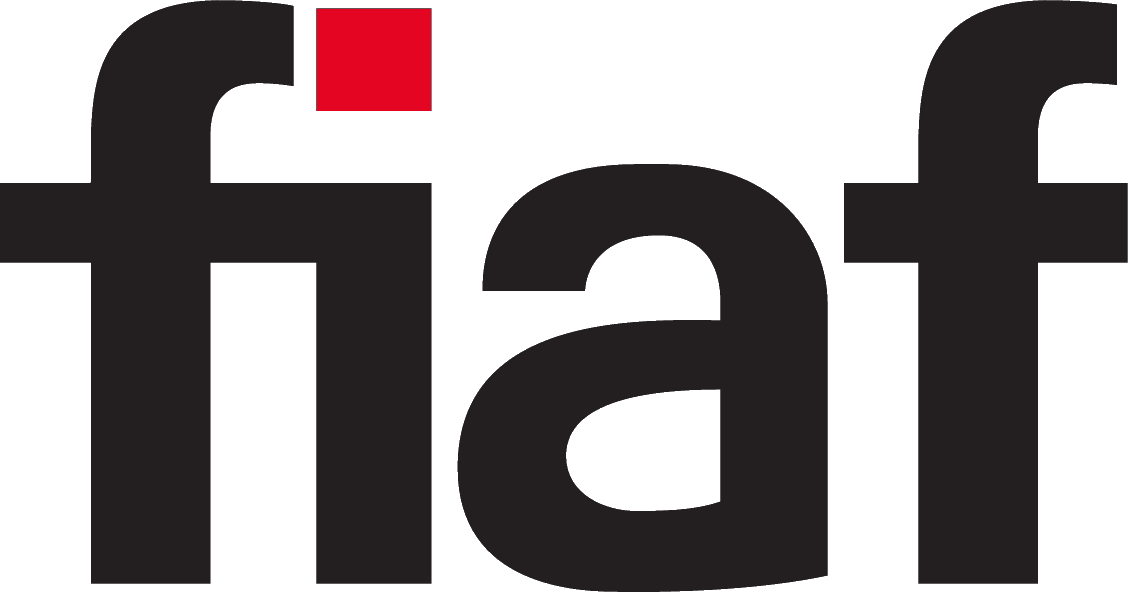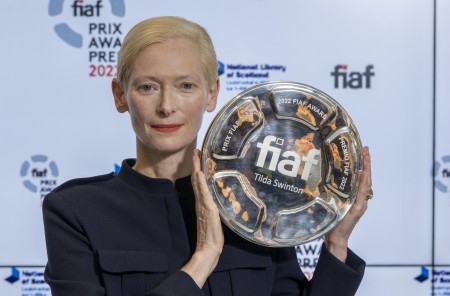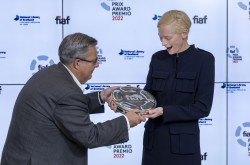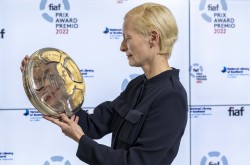2022 FIAF Award Presentation
Tilda Swinton was presented with the 2022 FIAF Award by the FIAF Executive Committee at the National Library of Scotland's Moving Image Archive in Glasgow on Monday 28 November 2022.
You will find below the video of the ceremony (with English subtitles), the text of Tilda Swinton's beautiful acceptance speech, and a photo gallery.
Videos of the Presentation Ceremony
Video of the full ceremony
Video of Tilda Swinton's acceptance speech
Tilda Swinton's Acceptance Speech
The cinema has always been inextricably bound up with travel, with luggage, and with the intoxicating atmosphere of mixed feelings for me.
My first experience of a cinema was in a newsreel theatre ‒ the Cameo Royal in Charing Cross station in London.
This was a place packed with significant emotion for my brothers and me: it was where as young children we caught the trains that took us to our boarding schools ‒ journeys out of the comfort and security of our family life and into the adventures and perils of the unknown (and the known-to-be uncomfortable and insecure). Journeys that demanded some courage and a certain amount of performing being all right, journeys out of ourselves and into society.
The ritual was reliable: the tickets were bought, the luggage deposited in a safe box, and we went to the pictures. I never asked my mother if she ever reflected latterly on quite what a favour she was doing me by slipping me this drug. But I thank her now for it.
The Classic Royal cinema itself was the mistress of transformation and had only recently changed her skin again when I first went there at the age of six in 1967. Built in 1910 and from 1932 to 1956 a newsreel cinema, she then lived a saucy span when her name was changed to the Cameo Royal, and the policy of screening foreign-language (X) Certificate films began with Brigitte Bardot in Mam'selle Striptease [En effeuillant la marguerite, dir. Marc Allégret, 1956]. I remember asking my mother what X meant on the corner of an old poster as we queued to buy sweeties and being thoroughly thrilled to the core by how flustered she got.
My fancy is that ‒ beyond the films that we saw there ‒ the only three that stick in my mind are The General, which we watched three times in a row due to a massive and fabulously delaying snowstorm, Herbie Rides Again, and the Agatha Christie where they are all bumped off one by one until there are only two left and you are encouraged to leave the cinema for a few minutes while a clock face is shown on the screen and your mother smokes a cigarette and you all try to figure out who is the murderer (unforgettably exciting) ‒ my fancy is that this rich and switchback life of the building itself was somehow transmitted to me during those bewitching visits throughout my young years and imprinted itself on my relationship with cinema ever after. It certainly felt that this was the site of endless possibilities ‒ a haven, a sanctuary, and a portal to escape, happiness, thrill, and rescue.
I suppose it was there that it first occurred to me.
There’s no such thing as an old film.
Buster Keaton was my chum then. He looked as bemused by life as I was. He and I had an understanding ‒ and he has never failed me since.
Now, as a filmmaker, I know something else:
There’s no such thing as a new film.
When we look up at the big screen to images shot at the turn of the 19th and 20th centuries, and ever since, we are there and then, presence distilled.
When we call “cut” on a take of film run through a camera, we have bottled the moment ‒ and time no longer applies.
The work that FIAF pitches itself towards is the preservation of the very seeds of our cinema culture. You grow the very possibility of a future for film ‒ painstakingly, like a child growing cress on a flannel, and with a comparable sense of reverence and wonder.
Last year somebody gave me a magic substance in a jar. She told me that with it I would being able to grow my own kefir. Every morning I feed this creature with new milk and hey presto, we have a living yoghurt plant in our larder.
This somewhat unprepossessing blob of stuff, I learn, is referred to as the mother. Keep her safe and she will grow the new.
This all popped into my head as I cast about for a way to describe the essential significance of a healthy archive to a living culture.
A blob of stuff.
In the paramount engine room of cinema identity, FIAF and the incalculably important work it does forms the mothership of legacy and the Eveready battery of film forever.
Not only the roots of film made before we were born, but also its trunk, its branches, and its buds and leaves are all essential to our finding an anchor in the very concept of a cinema for the future. We need to distil that sense of sanctuary, of open possibility, and the humane power of lending others our eyes and hearts that cinema offers and delivers us.
Like the kefir, we know that cinema is good for us. And we know that it must be grown carefully.
In the hands of FIAF, the archive of our world cinema heritage, far from being a boxed-up and shelved attic, full of discarded remnants, redundant and burdensome, is, rather, the vibrant kitchen ‒ the hearth and the larder ‒ of culture’s house.
Little nourishing proceeds from anywhere else it sometimes seems: the source drives us forward always.
It is a simple fact that there is no way that I could have had the nerve to step in front of a camera without my early devotion to Buster Keaton, to Roger Livesey, to Anton Walbrook, to Greta Garbo, to Alastair Sim, to Carole Lombard, to Alec Guinness, to Delphine Seyrig.
They are my contemporaries, my companions, and my beacons, and the robustness of their eternal presence informs my journey through the forest as I follow their breadcrumbs, in my curious quest for gestures that might count.
But when I think of our great treasure of cinema history, I find myself thinking most resonantly of the mighty company of trees. Not only because of the majesty of the way in which the movement of film culture seems to undulate in grand swathes, as if blown like treetops in a high wind. But also because of the way in which they are connected under the surface ‒ the society of films, like the society of trees, is a pure and never-ending wonder to me.
Because films relate to each other, they speak to each other and keep fellowship with one another. Sometimes they get into fisticuffs and sometimes they come to each other’s aid and defence. There are certain kinships identifiable between certain films across cinema history, not bound by era or geography, but by a matter of spirit and complicity in purpose.
And so maybe the power of cinema in our culture feels to me most accurately compared to the magic of mycelium underground: connecting and transmitting, informing, supporting, feeding, and healing. It charges our batteries and sets our clocks. We sail our ships by its runes, in all weathers, under all skies.
Even in the dark.
Even in the pitch blackness.
To describe my gratitude on being recognized in this way by this organization for which I have such profound respect is ‒ frankly ‒ beyond my power. The honour that you pay me today takes pretty much all the biscuits. I am deeply touched and encouraged to the hilt. This is an army I am proud to march with, a banner I fly with conviction and certainty, an anthem I know the words to ad infinitum:
Long live FIAF and all who sail in her!
Long live the State of Cinema and all her ways!
Long live the wild, wide screen!
Film forever!
Nothing but love…
Tilda Swinton
Glasgow, 28 November 2022
Photo Gallery



























